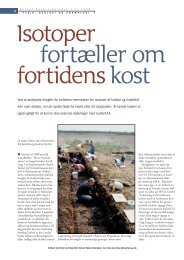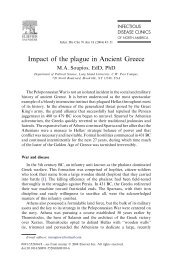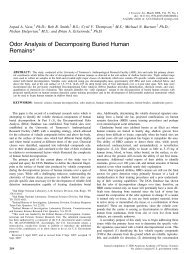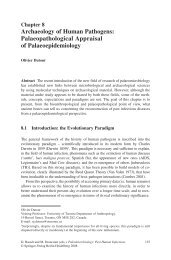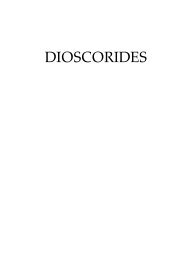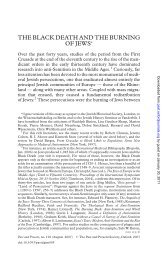1 Paleoradiology: History and New Developments - Academia.dk
1 Paleoradiology: History and New Developments - Academia.dk
1 Paleoradiology: History and New Developments - Academia.dk
You also want an ePaper? Increase the reach of your titles
YUMPU automatically turns print PDFs into web optimized ePapers that Google loves.
ard of Philadelphia acknowledged that “the advent of<br />
the Roentgen method into the diagnosis of fractures<br />
has created the highest st<strong>and</strong>ard by which the results<br />
obtained in the treatment of fracture must be judged”<br />
(cited by Walsh 1907, p 186). Golding Bert urged “that<br />
radiography should be regarded as a subsidiary agent<br />
to diagnosis, <strong>and</strong> its evidence in cases of doubt <strong>and</strong><br />
difficulty should be received with caution, <strong>and</strong> only<br />
after due interpretation by someone whose experience<br />
warrants his speaking with authority” (cited by<br />
Walsh 1907, p 198). Skiagraphy was coined in April<br />
1896 by a 24-year-old medical student, Sydney D.<br />
Rowl<strong>and</strong>, who served as editor of the world’s first<br />
radiological journal called “Archives of Clinical Skiagraphy,”<br />
which was devoted to new photography in<br />
medicine <strong>and</strong> surgery. In the preface of that first journal<br />
on radiology, Rowl<strong>and</strong> wrote: “the object of this<br />
publication is to put on record in permanent form,<br />
some of the most striking applications of the new<br />
photography to the needs of medicine <strong>and</strong> surgery.<br />
The progress of this new Art has been so rapid that,<br />
although Prof. Roentgen’s discovery is only a thing of<br />
yesterday, it has already taken its place among the approved<br />
<strong>and</strong> accepted aids to diagnosis…the first essays<br />
were of a rough <strong>and</strong> ready character; week after<br />
week, however, improvements have been made in the<br />
practical applications of the Art which I venture to<br />
call skiagraphy; <strong>and</strong>, at the present time, we are in the<br />
1.5 <strong>Paleoradiology</strong> <strong>and</strong> Clinical Radiology: Historical Development<br />
Fig. 1.11. Magnetic resonance<br />
imaging of Nakht’s<br />
brain<br />
position to obtain a visible image of every bone <strong>and</strong><br />
joint in the body…” (Burrows 1986).<br />
This brief review of the literature on radiology in<br />
the early phase of development of x-ray technology<br />
shows there was a considerable corpus of literature<br />
on radiology of bone pathology, indicating the availability<br />
of radiological expertise that paleopathologists<br />
could have used to enhance their attempts to detect<br />
skeletal lesions in mummies or dry bone specimens<br />
from archeological settings. The lack of actual interaction<br />
between radiologists <strong>and</strong> anthropologists/paleopathologists<br />
still plagues the methods <strong>and</strong> practice of<br />
paleopathology 100 years after the discovery of x-rays<br />
by Roentgen. One hundred <strong>and</strong> ten years after the first<br />
x-ray study of bioarcheological material performed by<br />
Koenig on a human <strong>and</strong> an animal Egyptian mummy,<br />
<strong>and</strong> despite the publication of paleoradiological articles<br />
in numerous <strong>and</strong> diverse scientific journals, there<br />
is still no single didactic paleoradiology book available<br />
to teach both the method <strong>and</strong> diagnostic approach<br />
of this discipline. Hence our endeavor to produce this<br />
book to fill this gap.<br />
Although Harris et al. published two unique books<br />
on x-ray studies of royal Egyptian mummies, their<br />
purpose was not to teach paleoradiology, but instead<br />
to offer a kind of radiographic database of mummies<br />
for researchers in the field of Egyptology <strong>and</strong><br />
mummy science (Harris <strong>and</strong> Weeks 1973; Harris <strong>and</strong><br />
11



